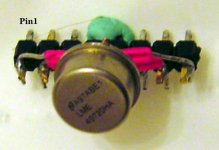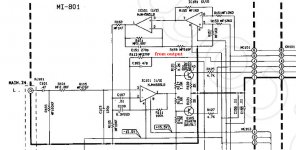Hi
Is there a direct (but much better) replacement ic, with very much lower distortion, to replace the NJM4565 op amp ic (with same pinout) ?
Thank
Gaetan
Is there a direct (but much better) replacement ic, with very much lower distortion, to replace the NJM4565 op amp ic (with same pinout) ?
Thank
Gaetan
Any standard Bipolar Opamp thould work as a replacement Like even the NE5532 would be better (Much faster and Lower noise)...
That is if your 4565 is in the Dip8 package.....
Cheers
That is if your 4565 is in the Dip8 package.....
Cheers
Minion said:Any standard Bipolar Opamp thould work as a replacement Like even the NE5532 would be better (Much faster and Lower noise)...
That is if your 4565 is in the Dip8 package.....
Cheers
Hi
No, my 4565 are in SOIC package. It's the output op amp of my Ensoniq audio pci soundcard.
And I have some 5532 in Dip 8 package.
Thank
Gaetan
Why don´t you try the real ones,Lm4562 SOIC.😎 🙂It's the output op amp of my Ensoniq audio pci soundcard.
I have tried a direct substitute the input IC101 NJM4565LB of the Carver TFM-25 with the 49720HA without success.
Any suggestion?
Any suggestion?
Attachments
Last edited:
In what way no success ?
Which of the three opamps shown does this replace ? Top two or the single input device. Have you scoped the opamp to see its stable ? Use a scope on all pins to get a true "DC" reading. All the evidence will be there 🙂
Which of the three opamps shown does this replace ? Top two or the single input device. Have you scoped the opamp to see its stable ? Use a scope on all pins to get a true "DC" reading. All the evidence will be there 🙂
If there is no sound at all then I would suggest either a wiring error in rigging the opamp to fit or that the opamp isn't what it says... a fake.
Write down the voltages for all 8 pins and lets see what we can deduce !
Write down the voltages for all 8 pins and lets see what we can deduce !
OK, fair enough.
Well... you have to start somewhere and that means checking that you are 100% sure you have wired it correctly. Then measure and record the voltages on the PCB corresponding to the pin outs of the IC. Measure on the board itself.
There are only a few options why it doesn't work.
1/ Its duff.
2/ Its wired incorrectly
3/ Its doing something weird in that configuration. (doubtful)
Post your measure voltages for all 8 pins and we'll see what we come up with.
Well... you have to start somewhere and that means checking that you are 100% sure you have wired it correctly. Then measure and record the voltages on the PCB corresponding to the pin outs of the IC. Measure on the board itself.
There are only a few options why it doesn't work.
1/ Its duff.
2/ Its wired incorrectly
3/ Its doing something weird in that configuration. (doubtful)
Post your measure voltages for all 8 pins and we'll see what we come up with.
Just a question: I know LM4562 is supposed to be for hifi application. I have not found the internal circuits of the LM4562, but I see the schematic of NJM4565, it is as simple as it gets.
Is there any difference between a regular high slew rate low noise opamp to the specialized LM4562?
Is there any difference between a regular high slew rate low noise opamp to the specialized LM4562?
Data sheet representations are often simplified omitting much of the internal circuitry. Opamp differences do show sonically... hard to define, defies measurement very often, and yet they exist. All that assumes the devices are used correctly for the intended application.
- Status
- Not open for further replies.
- Home
- Design & Build
- Parts
- Is there a better replacement for the NJM4565 op amp ic


